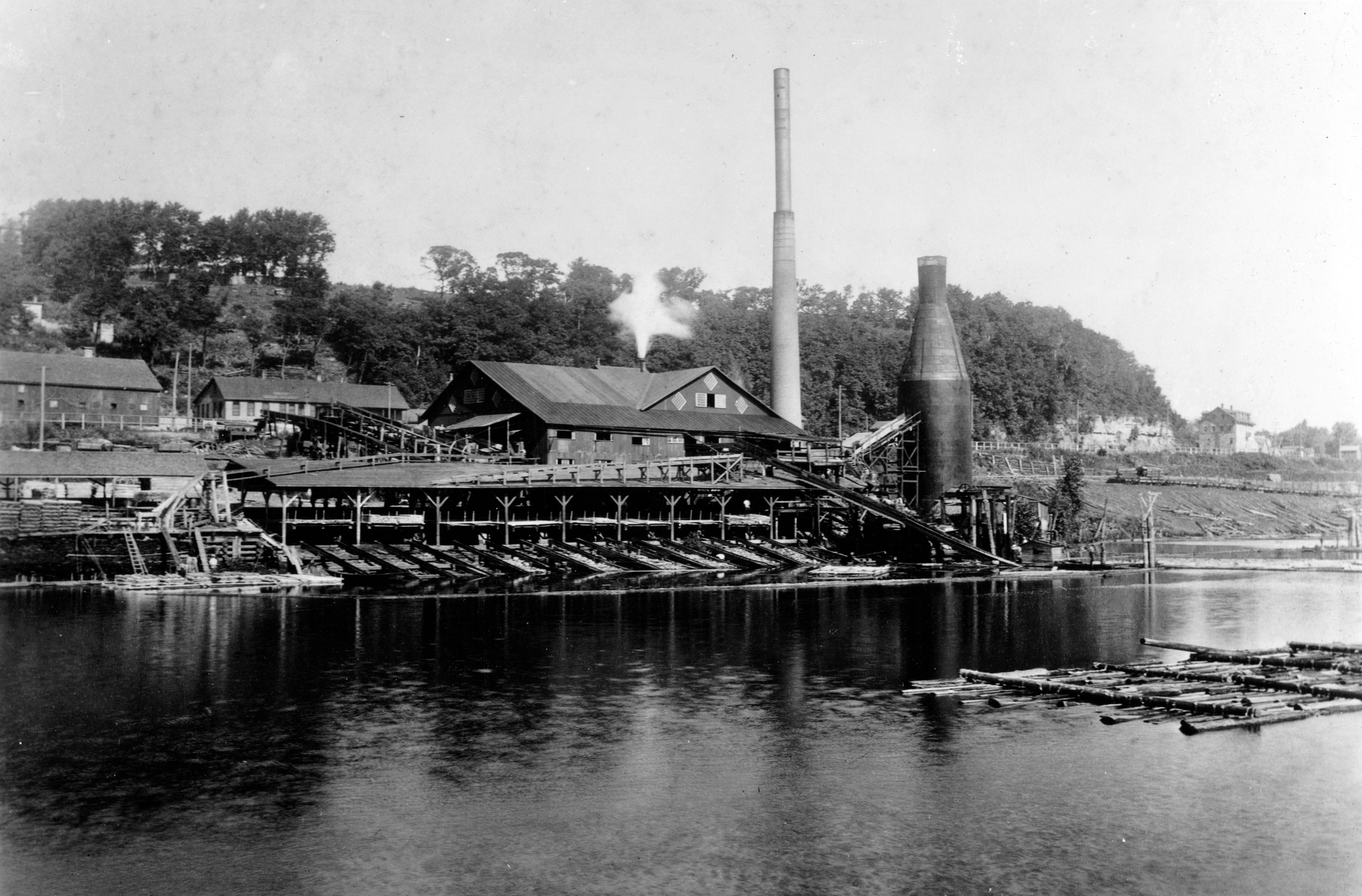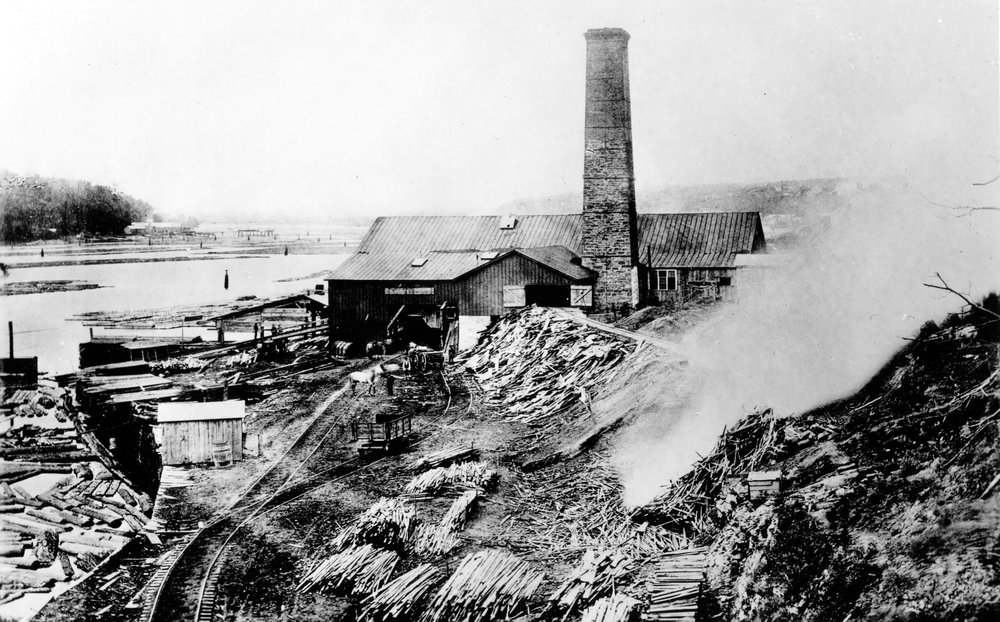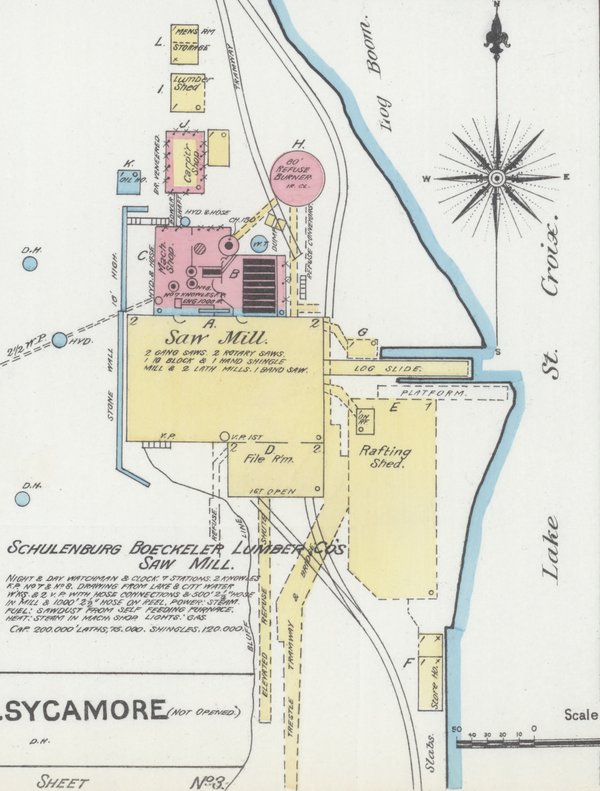Schulenburg & Boeckeler Mill
There were several mills along Stillwater's riverfront. One of the largest was located on the north end of town. It was started by two men from St. Louis and would be a major factor in the lumber industry for over 50 years. This was the Schulenburg & Boeckeler Mill.
Frederick Schulenburg and Adolphus Boeckeler, both of St. Louis, came to the valley in 1853 to look for land and a site for a lumber mill. They located the mill in the northern part of Stillwater where Joseph R. Brown had set up his town site of Dakotah some thirteen years earlier.
In the April 13, 1854 edition of the Minnesota Pioneer, editor Joseph R. Brown commented that “Messrs. Schulenburg, Boeckeler & Co. are making preparations for the erection of an extensive mill in the upper part of town, to run some twelve saw…” Later, in the September 13, 1854 Daily Minnesotian, editor John P. Owens wrote: “The extensive saw mill of Messrs. Schulenburg & Buckler is nearly ready to commence operations.”
In the first year of operation, the mill produced more than ten million board feet of lumber. The first sawing was done with an old-fashioned sash saw, but a gang containing some 20 saws was put in, and the following winter a flooring rotary saw was added. During the winter of 1856-57, the old sash saw was taken out and a small live gang of 18 saws put in its place.
In April 1857, Louis Hospes became a partner and the firm name changed to Schulenburg, Boeckeler & Company. Hospes was born in Germany on February 8, 1809 and came to Stillwater in 1853 as an employee of the company. He continue with the company until January 1, 1878 when he retired. Upon his retirement, Charles W. Behrens and E.L. Hospes became members of the company.
In June 1868, a 56-inch rotary was put in the mill. During the winter of 1873-74, a sixth boiler was added and the old steam dome and mud drum replaced by new ones.
On May 16, 1877, disaster struck the mill when it caught fire. The St. Paul Pioneer Press said, “The loss is estimated at $80,000 with a probable insurance of $15,000.” The article continued by saying, “The cause of the fire is unknown, but it is supposed to have occurred from the friction of the belt over a pulley as the same thing happened once before. No lumber was lost as men slid all the planed boards into the lake. The machinery is almost worthless.”
The mill was later rebuilt and more than 150 men who had been thrown out of work once again found employment there.
The mill and the lumber company had housing for the workers. Small, simple houses that were constructed by the company, which the mill hands would stay. This portion of the city became known as “Charlottenburg” named for the wife of Frederick Schulenburg – but later it became known as “Dutchtown,” and was a community within itself for generations.
On February 14, 1880, the firm of Schulenburg, Boeckeler and company of Stillwater and the St. Louis firms of Schulenburg and Boeckeler, and A. Boeckeler and Company, were all incorporated together and the firm name was changed to the Schulenburg and Boeckeler Lumber Company with A. Boeckeler, president, E.L. Hospes, vice-president; Charles W. Behrens, secretary; and L.C. Hirshberg, treasurer.
In August 1892, the mill burned again. It was rebuilt, but the company never fully recovered. In 1893 the country went into a financial panic and in 1894, both Frederick Schulenburg and Adolphus Boeckeler died. With all of this, and a lawsuit brought on by William Carlisle & Co., the Schulenburg and Boeckeler Lumber Company went into receivership, or bankruptcy, in November 1894.
The lumber company and all its assets were sold in June 1895 to Isaac Staples. He in turn sold the property to the Staples-Atlee Company. They operated the mill until 1901 when it was sold to George Atwood, who operated it as his “B” mill.
The mill again burned in 1907. This time, the rubble was cleared away but the mill was never rebuilt.
Eventually the property ended up with the Aiple, family who construction a home near the river. Recently the City of Stillwater purchased the property and this will become a community park called “Lumberjack Landing.”
—Brent Peterson
Brent Peterson is the Executive Director of the Washington County Historical Society.



